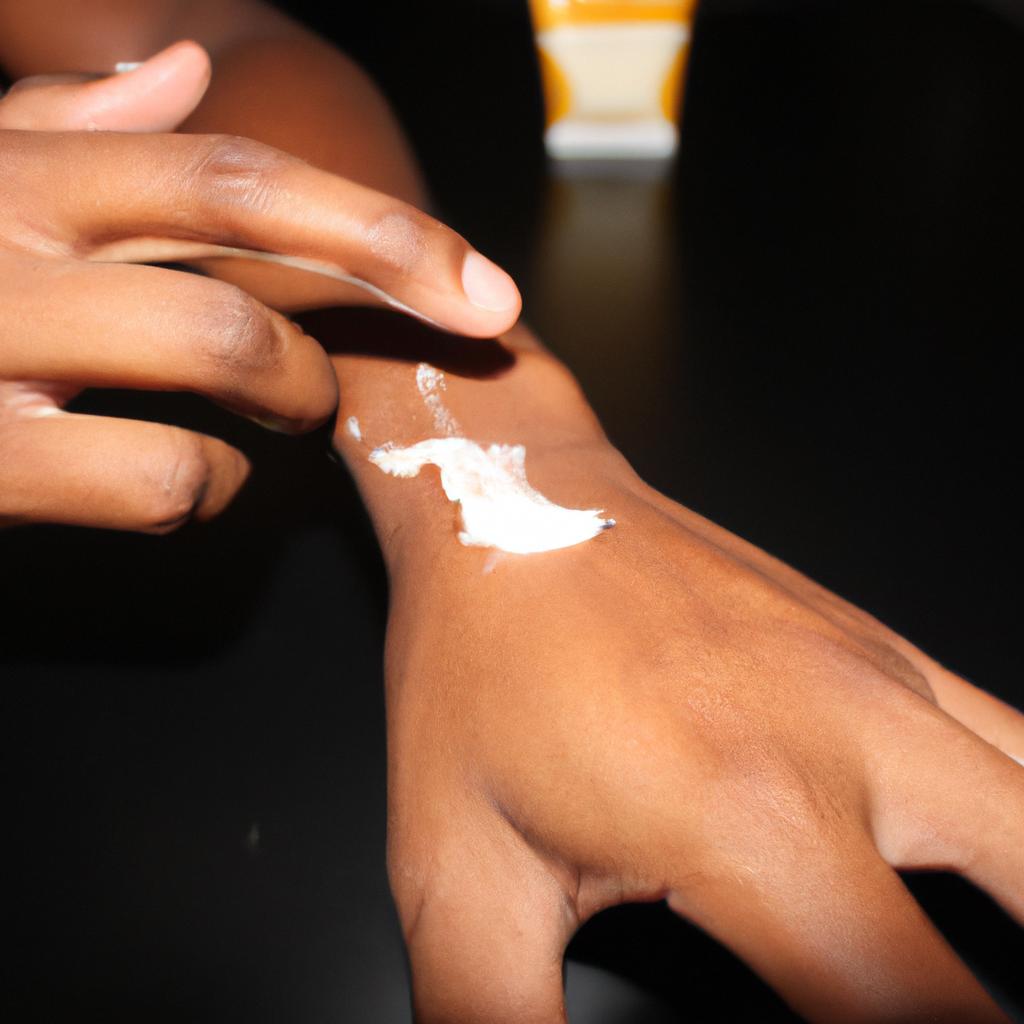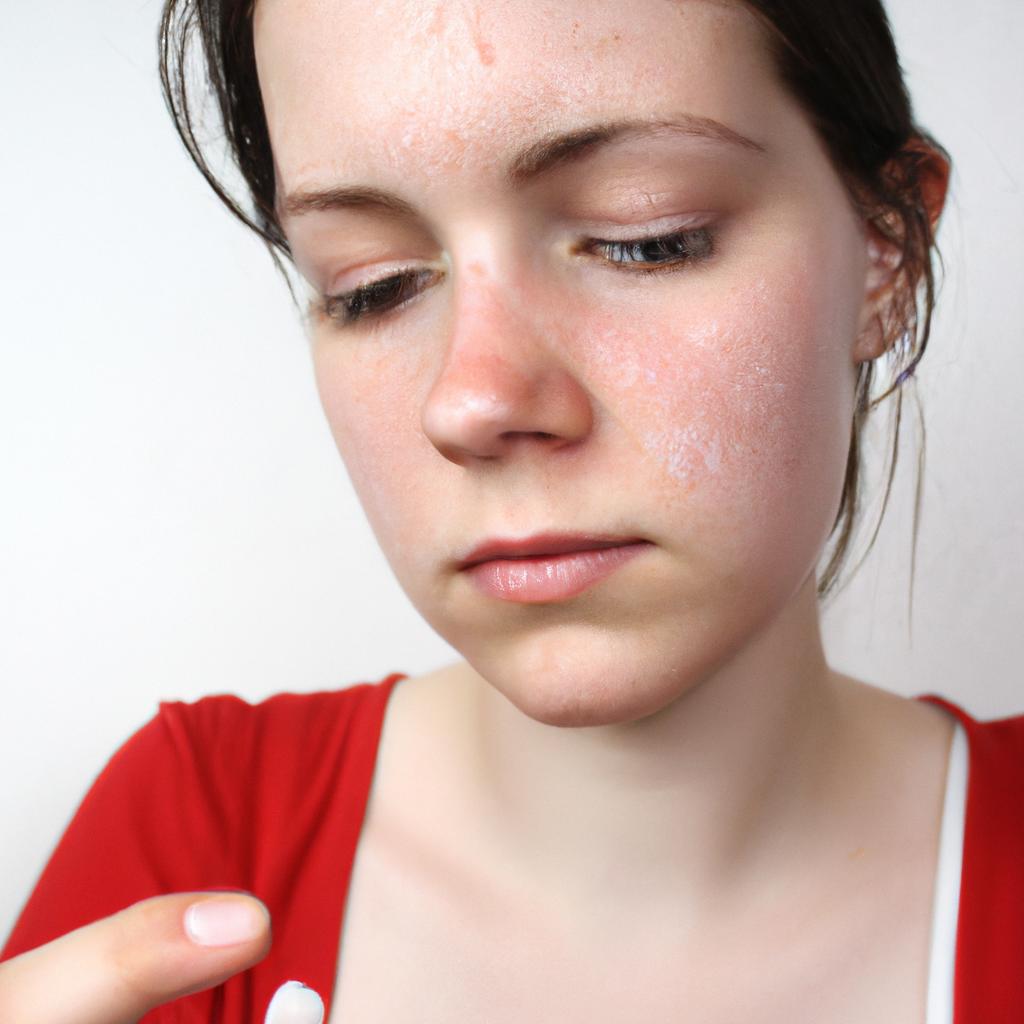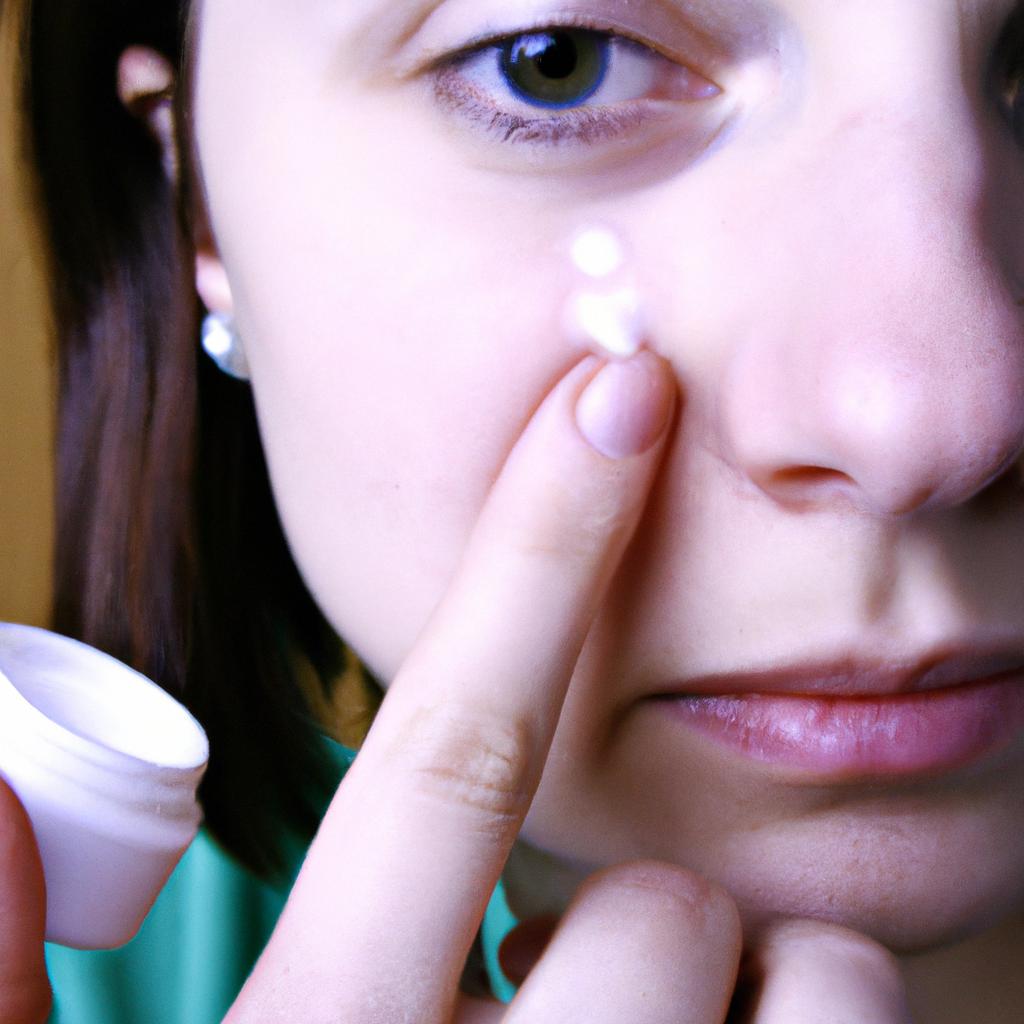Sensitivity in skin care products has become a growing concern among consumers worldwide. The use of various chemicals and ingredients in these products can often lead to adverse reactions, such as redness, irritation, and even allergic responses. For instance, consider the case of Mrs. Johnson, a middle-aged woman who recently purchased a popular moisturizer advertised for its anti-aging properties. Within days of using the product, she experienced severe itching and swelling on her face, necessitating immediate medical intervention. This example highlights the urgent need to address problems related to sensitivity in skin care products.
The presence of harmful substances in skin care products poses significant risks not only to individuals but also to public health at large. Recent studies have revealed that certain chemical compounds commonly found in cosmetics may disrupt hormonal balance or cause long-term damage to the skin barrier function. These findings underline the importance of identifying potential allergens and irritants proactively. Additionally, it is crucial to explore alternative formulations that prioritize safety without compromising effectiveness. Consequently, this article aims to analyze different aspects surrounding sensitivity in skin care products and propose strategies for mitigating associated problems effectively. By examining relevant research literature and industry practices, we can gain insights into how manufacturers can develop safer and more reliable solutions for conscious consumers seeking optimal skin health and well-being.
One possible approach to addressing sensitivity in skin care products is through rigorous testing and regulation. Manufacturers should be required to conduct comprehensive safety assessments of their products before they are introduced into the market. This includes conducting patch tests on human volunteers to identify potential allergic reactions or irritant effects. Furthermore, regulatory bodies should establish stricter guidelines regarding the use of certain chemical ingredients that have been linked to skin sensitization. By ensuring that products meet stringent safety standards, consumers can have greater confidence in the skincare items they choose.
Another important strategy is to promote transparency and accurate labeling of skin care products. Many consumers with sensitive skin rely on specific product claims such as “hypoallergenic,” “fragrance-free,” or “dermatologist-tested” when making purchasing decisions. However, these terms are not always regulated or defined consistently across brands, leading to confusion among consumers. Implementing standardized definitions and criteria for such claims would help prevent misleading marketing practices and provide clearer information for individuals with sensitive skin.
Additionally, manufacturers can explore alternative formulations that prioritize natural and gentle ingredients. The rise of clean beauty trends has shown a growing demand for plant-based extracts, organic compounds, and other natural alternatives in skincare products. These ingredients often have lower risks of irritating or sensitizing the skin compared to synthetic chemicals commonly used in cosmetics. By embracing sustainable sourcing practices and investing in research on botanicals with proven efficacy and safety profiles, manufacturers can develop innovative solutions that cater to both sensitive skin concerns and environmental sustainability.
Furthermore, education plays a vital role in addressing sensitivity issues in skincare products. Consumers need access to reliable information about common allergens and irritants found in cosmetics so that they can make informed choices about what they apply on their skin. Providing clear instructions on how to perform patch tests or recommendations for gradual product introduction can also help individuals with sensitive skin avoid adverse reactions.
In conclusion, sensitivity in skincare products is a significant concern that requires proactive measures from both manufacturers and regulatory bodies. By prioritizing safety through rigorous testing, promoting transparency in labeling, exploring alternative formulations, and educating consumers, the skincare industry can develop safer and more reliable products that cater to the needs of individuals with sensitive skin. Ultimately, this will contribute to improved public health outcomes and enhance consumer trust in skincare products.
Understanding skin sensitivity
Skin sensitivity is a common concern among individuals, with many experiencing various symptoms such as redness, itching, and dryness. To illustrate the impact of skin sensitivity, consider the case study of Sarah, a 32-year-old woman who recently developed a rash after using a new skincare product. This example highlights the need to delve deeper into understanding skin sensitivity and addressing its associated problems.
To begin with, it is important to recognize that skin sensitivity can be triggered by numerous factors. These include environmental factors like sun exposure or harsh weather conditions, as well as chemical irritants commonly found in skincare products. Additionally, genetic predisposition and underlying medical conditions can also play a role in exacerbating skin sensitivities. Acknowledging these diverse triggers is crucial for developing effective strategies to mitigate their effects on the skin.
Furthermore, it is essential to understand how people perceive and experience skin sensitivity differently. While some may only experience mild discomfort or temporary reactions, others may suffer from chronic conditions that significantly impact their quality of life. The emotional toll of dealing with sensitive skin cannot be underestimated; individuals often feel self-conscious about their appearance and frustrated by the limited options available for managing their condition.
To shed light on the challenges faced by individuals with sensitive skin, consider the following bullet points:
- Constant worry about flare-ups
- Difficulty finding suitable skincare products
- Limited participation in outdoor activities due to fear of aggravating symptoms
- Negative impact on self-esteem and overall well-being
Additionally, utilizing a three-column table would further emphasize these challenges:
| Challenges | Impact | Coping Strategies |
|---|---|---|
| Worry about flare-ups | Increased stress levels | Develop a consistent skincare routine |
| Finding suitable products | Time-consuming trial-and-error process | Seek recommendations from dermatologists |
| Limited outdoor activity | Decreased enjoyment of physical activities | Use protective clothing and sunscreen |
| Negative self-esteem | Reduced confidence in social interactions | Engage in self-care activities |
In conclusion, understanding skin sensitivity requires acknowledging its multifaceted nature and the varied experiences individuals face. By recognizing the triggers and emotional impact associated with sensitive skin, we can better address these problems. In the subsequent section, we will explore common triggers of skin sensitivity and how to identify them effectively.
[Transition sentence: Moving forward, let us delve into identifying common triggers of skin sensitivity.]Identifying common triggers
Understanding skin sensitivity is crucial in addressing problems related to it. In the previous section, we explored various factors that contribute to skin sensitivity. Now, let us delve deeper into identifying common triggers that can cause adverse reactions in sensitive skin.
Imagine a scenario where a person with sensitive skin tries out a new skincare product containing fragrances and preservatives. Shortly after application, they experience redness, itching, and irritation on their face. This case study illustrates how certain ingredients commonly found in skincare products can trigger negative reactions in individuals with sensitive skin.
- Fragrances: Synthetic or natural fragrances added to skincare products may contain allergenic compounds that irritate sensitive skin.
- Preservatives: While necessary for product longevity, some preservatives like parabens and formaldehyde releasers can be sensitizing for certain individuals.
- Harsh Cleansing Agents: Aggressive surfactants such as sulfates can strip away the natural oils from the skin’s surface, causing dryness and irritation.
- Environmental Factors: External elements like pollution, extreme temperatures, and UV radiation can compromise the skin barrier function and exacerbate sensitivity.
Now let’s explore this information further by presenting a table comparing different types of ingredients commonly present in skincare products:
| Ingredient Category | Examples | Potential Skin Sensitization |
|---|---|---|
| Fragrances | Parfum | High |
| Limonene | Moderate | |
| Preservatives | Methylisothiazolinone | High |
| Phenoxyethanol | Low | |
| Surfactants | Sodium Lauryl Sulfate | High |
| Coco-Glucoside | Low |
This table provides an overview of ingredient categories along with specific examples and their potential to sensitize the skin. It serves as a useful reference for individuals seeking to avoid certain ingredients that may trigger their skin sensitivity.
In light of these triggers, it is essential to choose skincare products with suitable ingredients that cater to sensitive skin’s needs. The subsequent section will explore various considerations and guidelines for selecting appropriate ingredients, ensuring optimal care for sensitive skin without compromising its health and well-being.
Choosing suitable ingredients
Having identified the common triggers that can cause skin sensitivity, it is crucial to choose suitable ingredients for skincare products. By carefully selecting ingredients, we can minimize the risk of adverse reactions and create products that cater to a wider range of individuals with sensitive skin.
To illustrate the importance of choosing appropriate ingredients, let us consider a hypothetical scenario involving a person named Emily. Emily has been struggling with dry and sensitive skin for years. She used various skincare products without success until she discovered a moisturizer specifically formulated for sensitive skin. This product contained gentle botanical extracts known for their soothing properties, such as chamomile and oatmeal. The use of these natural ingredients helped alleviate Emily’s discomfort and provided her with much-needed relief.
When formulating skincare products for individuals with sensitive skin, manufacturers should prioritize ingredient selection based on certain criteria. Consider the following factors when deciding which components are best suited for inclusion:
- Hypoallergenicity: Opt for hypoallergenic ingredients that have lower potential to trigger allergic reactions.
- Non-comedogenicity: Choose non-comedogenic substances that do not clog pores or contribute to acne breakouts.
- Mildness: Use mild ingredients that are less likely to irritate or exacerbate existing sensitivities.
- Moisturizing properties: Incorporating hydrating compounds helps maintain optimal moisture levels while protecting against dryness.
Table: Potential Ingredients for Sensitive Skin Formulations
| Ingredient | Benefits | Examples |
|---|---|---|
| Chamomile | Soothes inflammation | Bisabolol |
| Oatmeal | Calms irritation | Colloidal oatmeal |
| Aloe vera | Hydrates and cools | Aloe barbadensis leaf juice |
| Green tea extract | Antioxidant properties | Camellia sinensis leaf extract |
By strategically selecting ingredients that possess these desirable qualities, skincare product manufacturers can create formulations that are gentle yet effective. This approach not only caters to individuals with sensitive skin but also appeals to a broader audience seeking products suitable for daily use.
With careful consideration given to ingredient selection, the next step involves testing for sensitivity. By conducting thorough assessments, we can ensure our skincare products meet the highest standards of safety and efficacy while minimizing the risk of adverse reactions.
Testing for sensitivity
Sensitivity in Skin Care Products: Addressing Problems
Choosing suitable ingredients is crucial for developing effective and safe skin care products. However, even with careful selection, some individuals may still experience adverse reactions due to their individual sensitivities. This section will explore the importance of testing for sensitivity and provide practical guidance on addressing problems that arise.
To illustrate the significance of this topic, let us consider a hypothetical case study. Emily, a 35-year-old woman with sensitive skin, recently purchased a new moisturizer advertised as gentle and hypoallergenic. Despite these claims, she developed redness, itching, and inflammation after applying it for several days. This scenario highlights the need to address potential sensitivity issues proactively.
Testing for sensitivity can help identify problematic ingredients or formulations before they cause harm. Here are key steps to implement:
- Patch Testing: Before using a product widely on your face or body, apply a small amount on a discreet area like the inner forearm or behind the ear. Leave it undisturbed for at least 24 hours and observe any signs of irritation or allergic reaction.
- Gradual Introduction: When introducing a new product into your routine, start by using it sparingly every other day instead of applying it daily from the beginning. This approach allows you to monitor your skin’s response gradually.
- Ingredient Awareness: Familiarize yourself with common irritants such as fragrances, preservatives (e.g., parabens), sulfates, and certain essential oils known to trigger sensitivities in some individuals.
- Seek Professional Advice: If you experience persistent or severe reactions despite taking precautions, consult a dermatologist who can guide you through appropriate diagnosis and suggest alternative solutions tailored to your specific needs.
It is important to remember that everyone’s skin is unique; what works well for one person may not suit another due to variations in genetics, environmental factors, or underlying conditions. To further aid your understanding, the table below outlines common sensitivity reactions and potential causes:
| Sensitivity Reaction | Potential Causes |
|---|---|
| Redness | Fragrances |
| Itching | Preservatives |
| Inflammation | Sulfates |
| Allergic Reactions | Essential Oils |
By being attentive to your skin’s responses and taking necessary precautions, you can minimize the likelihood of adverse reactions and enjoy a more pleasant skincare experience.
As we delve into adapting your skincare routine in the subsequent section, it is vital to consider these sensitivities while making informed choices for healthier skin.
Adapting your skincare routine
Adapting your skincare routine is crucial when addressing sensitivity issues. One prime example of adapting a skincare routine to address sensitivity is the case study of Sarah, a 30-year-old woman with sensitive skin prone to breakouts. Previously, she followed a conventional skincare routine that included harsh cleansers and exfoliants. However, her skin became increasingly irritated and reactive over time.
To avoid further aggravation, individuals like Sarah should consider making the following adjustments in their skincare routines:
- Choose gentle cleansers: Look for mild cleansers specifically formulated for sensitive skin types. These products are typically free from fragrance, alcohol, and harsh ingredients that can strip away natural oils and disrupt the skin’s barrier function.
- Opt for minimalistic formulations: Simplify your skincare regimen by using products with fewer ingredients. This reduces the likelihood of potential irritants triggering sensitivities or allergies.
- Introduce soothing ingredients: Incorporate products containing calming ingredients such as chamomile extract, aloe vera gel, or oatmeal. These ingredients have anti-inflammatory properties and can help alleviate redness and irritation.
- Patch test new products: Before fully incorporating new skincare products into your routine, it is advisable to perform patch tests on a small area of your skin first. This helps determine if any adverse reactions may occur before applying them extensively.
By implementing these adaptations into their daily rituals, individuals dealing with sensitivity problems can significantly reduce discomfort and improve their overall skin condition.
In addition to adjusting one’s skincare routine, seeking professional advice becomes essential in managing sensitivity concerns effectively.
Seeking professional advice
Section H2: Adapting your skincare routine
Transitioning from a regular skincare routine to one that is sensitive-skin friendly can be challenging. However, with proper adjustments and understanding of your skin’s needs, it is possible to address the problems associated with sensitivity in skin care products. Let us explore some strategies for adapting your skincare routine.
For instance, consider the case of Sarah, who experienced redness and irritation after using a particular moisturizer. After consulting a dermatologist, she discovered that her skin was highly reactive to fragrances commonly found in skincare products. In response, Sarah made several changes to her routine:
- Simplify your regimen: Opt for fewer products containing minimal ingredients to reduce the risk of potential irritants. A simplified approach allows you to pinpoint specific triggers more easily.
- Patch testing: Before incorporating new products into your routine, perform patch tests on a small area of skin first. This helps identify any adverse reactions before applying the product all over.
- Avoid harsh ingredients: Certain ingredients like alcohol, sulfates, and artificial fragrances can aggravate sensitive skin. Look for gentle alternatives or fragrance-free options when selecting skincare products.
- Protect against environmental factors: Shield your skin from external aggressors such as pollution and UV rays by wearing sunscreen daily and considering additional protective measures like hats or scarves.
- Reduced discomfort and pain caused by irritated skin
- Increased confidence in appearance due to improved complexion
- Enhanced overall well-being resulting from self-care practices
- Greater peace of mind knowing that steps have been taken towards addressing sensitivity concerns
Additionally, below is an informative table summarizing key considerations when adapting your skincare routine for sensitivity:
| Consideration | Explanation |
|---|---|
| Simplify | Lessen complexity by using fewer products with minimal ingredients. |
| Patch testing | Conduct small tests on a limited area to check for adverse reactions. |
| Avoid harsh ingredients | Opt for gentle alternatives or fragrance-free options to minimize irritation. |
| Environmental protection | Shield your skin from external factors such as pollution and UV rays. |
In adapting your skincare routine, it is crucial to remain patient and consistent in order to observe positive changes over time. By implementing these strategies, individuals like Sarah can effectively address sensitivity concerns and achieve healthier, more comfortable skin.
 Stanley Beauty Care
Stanley Beauty Care



